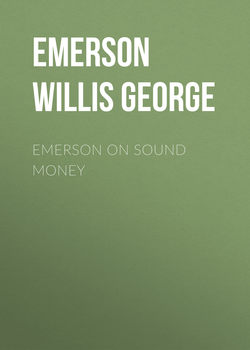Читать книгу Emerson on Sound Money - Emerson Willis George - Страница 7
JACKSON AND JEFFERSON
ОглавлениеThe patriotism and statesmanship of Andrew Jackson and Thomas Jefferson were untainted in 1792 by the dangerous influence of a coterie of silver barons. They simply ascertained as nearly as they could the relative or market value of the two metals, and determined the legal from the commercial ratio, placed them side by side and started our mints going with the unlimited coinage of gold and silver at the ratio of 15 to 1. As a matter of fact they had overvalued silver; that is to say, the gold dollar was worth 100 cents, but the silver dollar was only worth 98 cents. Now the rank and file of our forefathers cared very little about the discrepancy of the 2 cents on the dollars, but the money changers were abroad in the land in 1792, the same as they are in 1896, and whenever a gold coin came into their possession it was quietly retired from circulation. In other words, the cheaper money drove out of circulation the higher priced money, and as a result, we had silver as the only hard money currency circulating in this country from 1792 to 1834. Let me quote Thomas Jefferson's own words. In speaking of the ratio of the two metals, he says:
"THE PROPORTION BETWEEN THE VALUES OF GOLD AND SILVER IS A MERCANTILE PROBLEM ALTOGETHER."
What statement could be clearer and more concise than that? It being a mercantile problem, it of course was understood to be subject to fluctuation and change. Accordingly, in 1834 our forefathers concluded as their first attempt at a double standard had utterly failed in keeping the two metals circulating side by side as money, that they would change the ratio from 15 to 1 to 16 to 1, which they did. It seems this ratio undervalued silver, that is to say, the gold dollar was still worth 100 cents, but the silver dollar was worth from 102 to 103 cents. Gold at once became the hard money circulating medium in this country, silver the higher priced money, was entirely retired by the money changers, bullion dealers and silversmiths. This is another illustration where the cheaper money drove out of circulation the higher priced money.
